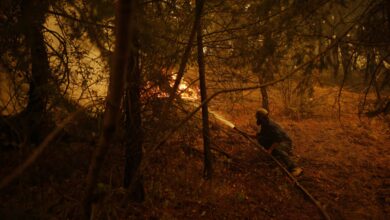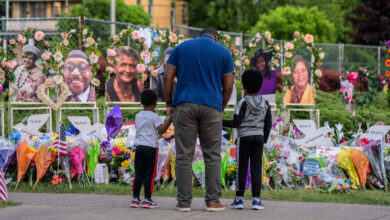Hurricane Norma makes landfall near resorts of Los Cabos on Mexico’s Baja California peninsula

Hurricane Norma has made landfall near the resorts of Los Cabos at the southern tip of Mexico’s Baja California Peninsula.
The U.S. National Hurricane Center says Norma, once a Category 4 hurricane, made landfall as a Category 1 hurricane with winds of 80 mph (130 kph) just south of Todos Santos.
Norma is expected to continue weakening over the weekend as it crosses into the Sea of Cortez, also known as the Gulf of California.
Norma is expected to bring heavy rains and potential flash floods to Baja and may hit the mainland coastal state of Sinaloa as a tropical storm. Hotels in Los Cabos remained about three-quarters full of tourists, but shelters were set up at schools in the resorts.
Residents of Los Cabos resorts rushed to prepare as Norma approached, while in the Atlantic, Hurricane Tammy threatened to batter the islands of the Lesser Antilles.
Businesses in Cabo San Lucas nailed up sheets of plywood over their windows, and government personnel hung up banners warning people not to try to cross gullies and stream beds after Norma regained strength and once again became a major storm Friday.
By early Saturday, Norma had weakened and was downgraded to Category 1 on the hurricane wind scale.
The hurricane was expected to continue on that path through the evening before turning to the northeast and slowing down through Monday. The forecast track would take a weakened Norma toward the mainland of Mexico’s western Pacific coast as a tropical storm.
Its languid pace raised the possibility of severe flooding. Norma was expected to dump six to 12 inches of rain with a maximum of 18 inches in places across southern Baja California and much of Sinaloa state.
According to the state civil protection agency, shelters in Baja California Sur housed some 1,500 people by Saturday morning.
The Los Cabos Civil Defense agency urged residents to stay indoors all day as winds and rain increased. Emergency workers rushed around the area evacuating people from low-lying areas and moving them to shelters.
Police in San Jose del Cabo rescued two people from their truck when a surging stream swept it away early Saturday. Some informal settlements, away from the hotels that serve tourists, were already isolated by rising water. Some neighborhoods lost electricity and internet service.
By late morning, the area’s streets were littered with palm fronds and other debris, and essentially deserted except for occasional military patrols. Strong winds whipped traffic signs, trees and power lines.
Visitors at hotels in Los Cabos, which are largely frequented by foreign tourists, made no major moves to leave en masse, Baja California Sur state tourism secretary Maribel Collins said.
There was no way out anyway: Airports were closed Saturday, according to the local civil defense office.
The local hotel association estimated there were about 40,000 tourists still in Cabo San Lucas and San Jose del Cabo on Friday.
At the marina in Cabo San Lucas, José Ceseña was hauling out of the water the boat he usually uses to ferry tourists around on tours. With the port closed to navigation and a hurricane coming, he said it wasn’t worth risking his craft.
Homero Blanco, the state commander of the National Guard, said beaches at the resort had been ordered closed and Guard troops were sent to clear people from the seashore.
The federal government posted 500 marines to the resort to help with storm preparations, and municipal officials said as many as 39 emergency shelters could be opened, if needed.
In the Atlantic, the U.S. National Hurricane Center said Hurricane Tammy had winds of 85 mph (140 kph), and hurricane warnings were issued for the islands of Guadeloupe, Antigua, Barbuda, Montserrat, and St. Kitts and Nevis. Tammy was moving northwest at 8 mph (13 kmh).
In the Atlantic, Hurricane Tammy was about 25 miles (40 kilometers) north-northeast of Guadeloupe and 50 miles (80 kilometers) southeast of the Caribbean island of Antigua.
Tammy was expected to remain at hurricane strength and even strengthen slightly as it moved toward the Lesser Antilles through Saturday passing by Guadeloupe, Antigua and Barbuda. Both Martinique and Guadeloupe are French overseas departments.
The hurricane center said in a report that “heavy rainfall and flooding (are) likely over much of the Lesser Antilles.”
Two weeks after Tropical Storm Phillippe rolled through Antigua and Barbuda dumping six to eight inches of rain and plunging both islands into darkness, residents of the islands braced for Tammy’s arrival. The slow-moving system was forecast to bring up to 12 inches over a twin-island nation where the devastation of Hurricane Irma in 2017 and recent wind damage and flooding from Philippe are still fresh memories.
“This means therefore, that the earth is still somewhat saturated and with additional rainfall, the potential for flooding is elevated,” Prime Minister Gaston Browne said in a nationwide broadcast on Friday afternoon. He urged residents to take all necessary steps to secure life and property.
Government offices, banks, and most non-retail businesses closed early on Friday to allow staff to prepare. Residents’ rush to stock up on necessities caused gridlock throughout St John’s and near popular shopping centers and supermarkets.
Local disaster management officials announced plans to open an estimated 40 shelters in communities throughout the country.




